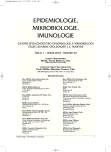Changes in the Bacterial Spectrum in Severe Burn Wounds
Authors:
B. Lipový 1; H. Řihová 1; M. Hanslianová 2; D. Burgetová 2; Y. Kaloudová 1; I. Suchánek 1; P. Brychta 1
Authors‘ workplace:
Klinika popálenin a rekonstrukční chirurgie FN Brno
1; Oddělení klinické mikrobiologie FN Brno
2
Published in:
Epidemiol. Mikrobiol. Imunol. 59, 2010, č. 1, s. 34-38
Overview
Study objective:
To determine the time axis for increase in Gram negative bacterial strains in burn wounds during hospitalization.
Study type:
Retrospective
Material and Methods:
Eighty-five patients hospitalized at the Clinic of burns and reconstructive surgery between 2006 and 2008 were enrolled in the study. The major criteria for enrolment were more than 15 % of total body surface area (TBSA) burned, hospital stay of 1 month or more and age over 18 years. Specimens for microbiological examination were collected on days 2, 6, 10, 14 and 20 after admission.
Results:
A total of 777 bacterial strains were isolated from the study patients, with 64.6 % of these strains being Gram positive and 35.4 % Gram negative. The most frequently isolated Gram positive pathogens were coagulase-negative Staphylococcus (260 strains) and Bacillus sp. (113 strains), while the most common Gram negative pathogens were Pseudomonas aeruginosa (81 strains), Escherichia coli (63 strains) and Acinetobacter calcoaceticus – baumannii complex (57 strains).
Conclusion:
The study provided data that supports the assumption of increase in Gram negative bacterial strains in burn wounds during hospitalization. Nevertheless, even on day 20 after admission, such strains did not predominate.
Key words:
burns – burn wound area – Gram positive bacteria – Gram negative bacteria.
Sources
1. Van Saene, H. K. F. Infection Control in the Intensive Care Unit 2nd Edition. Milan: Springer, 2005, 379-415.
2. Šrámová, H. a kol. Nozokomiální nákazy II. Praha: Maxdorf, 2001, 113-124.
3. Kolář, M. Infekce u kriticky nemocných. Praha: Galén, 2008, 261-266.
4. Königová, R.et al. Komplexní léčba popálenin. Praha: Grada,1999, 285-299.
5. Erol, S., Altoparlak, U., Akcay, M. N., Celebi, F., Parlak, M. Changes of microbial flora and wound colonization in burned patients. Burns, Vol. 30, Issue 4, June 2004, 357-361.
6. Herndon, D. N. Total Burn Care 3rd Edition. Philadelphia: Saunders Elsevier, 2007, 136-177.
7. Pospíšilová, A., Franců, M. Akutní a chronické rány – etiologie, rozdíly v hojení a léčba. Čes-slov Derm, 2008, 83, No. 5, 232-245.
8. Teodorczyk-Injeyan, J. A., Sparkes, B. G., Mills, G. B., Peters, W. J. Immunosuppression follows systemic T lymfocyte activation in the bun patient. Clin Exp Immunol, 1991, 85[3], 515-518.
9. Babík, J., Bodnárová, L., Sopko, K. Acinetobacter - serious danger for burn patients.Acta Chir Plast, 2008, 50[1], 27-32.
10. Albrecht, M. C., Griffith, M. E., Murray, C. K., Chung, K. K., Horvath, E. E., Ward, J. A., Hospenthal, D. R., Holcomb, J. B., Wolf S. E. Impact of Acinetobacter infection on the mortality of burn patients. J Am Coll Surg, 2006, 203[4], 546-550.
11. Mese, S., Nergiz, S., Gul, K., Girgin, S. Microorganisms isolated from burn wounds and their antibiotic susceptibility.J Burn Care Res, 2008, 29[6], 1018.
12. Trottier, V., Segura, P. G., Namias, N., King, D., Pizano, L. R., Schulman, C. I. Outcomes of Acinetobacter baumannii infection in critically ill burned patients.J Burn Care Res, 2007, 28[2], 248-254.
13. Guggenheim, M., Zbinden, R., Handschin, A. E., Gohritz, A., Mehmet, A., Giovanoli, A., Giovanoli, P. Changes in bacterial isolates from burn wounds and their antibiograms: A 20-year study [1986–2005]. Burns, 2009, 35[4], 553-560.
14. Svoboda, P., Kantorová, I., Řehořková, D., Scheer, P. Sepse v traumatologii a chirurgii. Praha: Triton, 2004, 139-143.
Labels
Hygiene and epidemiology Medical virology Clinical microbiologyArticle was published in
Epidemiology, Microbiology, Immunology

2010 Issue 1
Most read in this issue
- Nocardia farcinica as the Causative Agent of a Brain Abscess in a Patient with Interstitial Lung Disease
- The Incidence of Tularemia in Slovakia in 1997-2008
- Exotic Pets as a Potential Source of Salmonella
- A Steady Rise in Incidence of Pertussis Since Nineties in the Czech Republic
